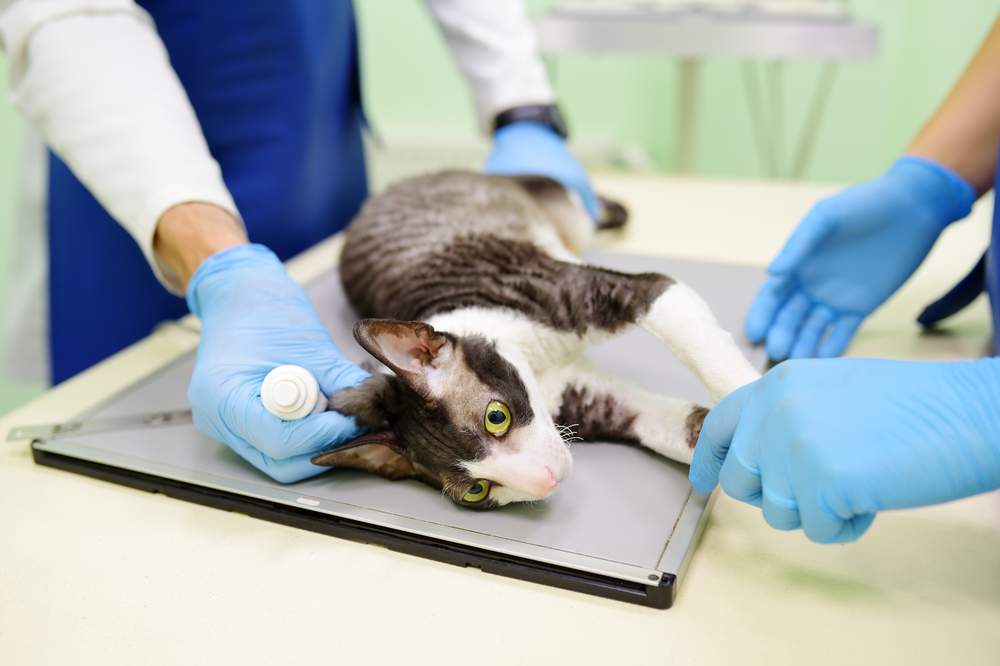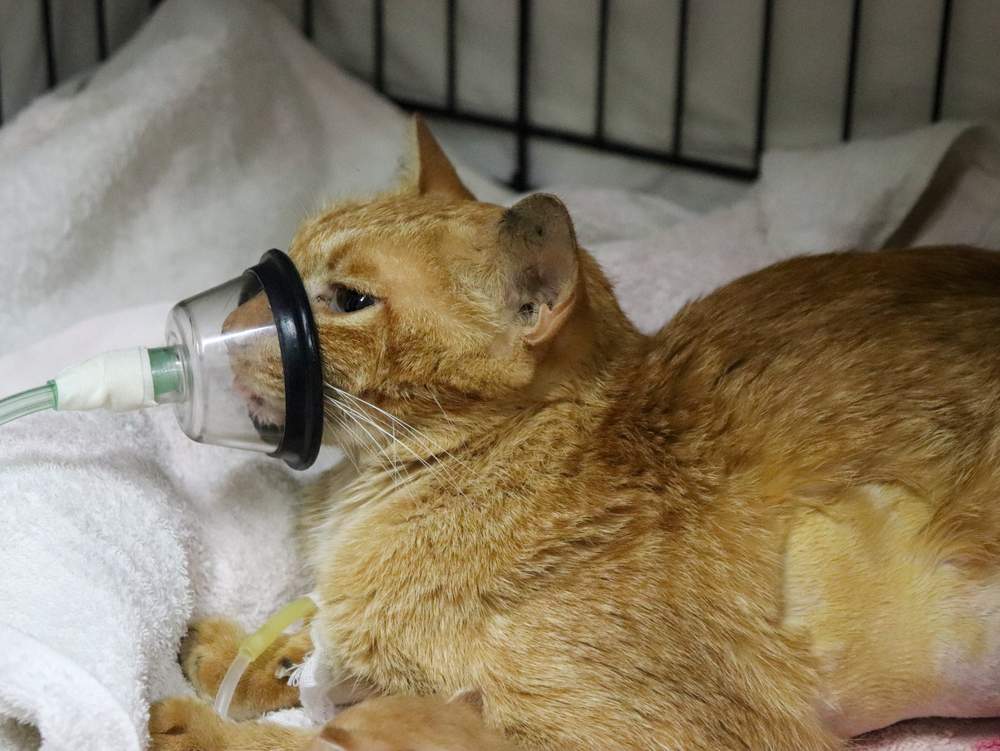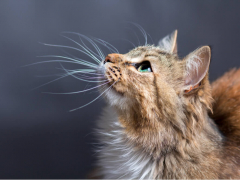
Panting, difficulty breathing and collapse are common signs of anaphylaxis. Sari ONeal / Shutterstock.com
Anaphylaxis (also known as acute systemic anaphylaxis) is a severe overreaction by the immune system, which instead of protecting the animal, creates physiological effects which cause harm to the pet. This exaggerated immune response can be minor, affecting just parts of the body – an allergic reaction – or severe and systemic affecting the whole body – anaphylaxis.
Whole-body allergic reactions (anaphylaxis) are life-threatening, genuine emergencies. The pathophysiology is complex, involving IgE antibodies from the cat’s immune system provoking the release of large numbers of defensive white blood cells into the circulation, along with high levels of inflammatory mediators such as histamine.
Anaphylaxis is only seen rarely in cats, but it can be so severe, dramatic and dangerous that it’s important that all cat owners recognize the signs so that prompt life saving action can be taken.
Causes of Anaphylaxis
Local allergic reactions (hypersensitivity) are common in cats: these usually just affect the skin, causing skin reddening, itchiness, urticaria (hives, like nettle stings), and swelling under the skin. Causes of local hypersensitivity reactions include food, insect bites, vaccines, and some medications. Rarely, a local allergic reaction can be a precursor to a major anaphylactic reaction. Anaphylaxis can develop in response to exposure to any allergen, whether in the food, inhaled, given by injection (e.g. vaccines), or even contact via the skin (e.g. insect bite or bee sting).
There is a long list of possible causes of anaphylaxis: any protein that comes into contact with the body can provoke this reaction. Peanut allergy in humans is a good comparison that many people may be aware of: even the smallest trace of peanuts, in food, on skin, or even inhaled, can provoke a severe reaction in some humans. The same principle applies to cats, and the problem is that until there is a reaction, there is usually no prior warning that this may happen. It is usually a sudden and life-threatening surprise, which makes anaphylaxis very difficult to deal with.
Examples of items that can have been known to provoke anaphylaxis in cats include:
- Insect stings or bites
- Vaccination
- Medication including antibiotics or anesthetics
- Venom (e.g. bees, wasps, snake bites, poisonous spiders, certain tropical fish or other types of reptile venom)
- Environmental allergens including dust, molds, pollens and dander (skin flakes that fall off the body of an animal)
- Proteins in the food (e.g. fish, dairy products or wheat)
- Flea or animal saliva
- Certain chemicals, such as cleaning products or pesticides
Symptoms of Anaphylaxis
While signs can vary, the predominant symptoms reported for feline acute systemic anaphylaxis include:
- Panting and dyspnea (difficulty breathing)
- Cyanosis (purplish-blue gums)
- Vomiting and diarrhea
- Excessive salivation
- Swelling of the face or limbs
- Incoordination
- Collapse
- Urination
- Tachycardia (rapid heart rate)
These signs generally have a very rapid onset, and severe intensity. Affected animals should be rushed to the veterinarian immediately.
Diagnosis of Anaphylaxis

Radiography (x-rays) may be used to rule out other causes of the signs of anaphylaxis. Maria Sbytova / Shutterstock.com
If you take a cat with signs of possible anaphylaxis to a DVM veterinarian, the following steps may be taken, although it’s very likely that your cat will be given immediate treatment without delay, while the process of investigation and diagnosis continues.
1. Detailed History Taking
Your vet will discuss every aspect of your cat’s condition and overall health care, including asking questions such as whether or not your cat is an outdoor or indoor cat. Any possible exposure to possible allergens should be mentioned, including recent vaccinations, flea treatments, garden chemicals, plants, medications, household chemicals and food items.
2. Physical Examination
Your veterinarian will check your cat over carefully, taking the heart rate, listening to the heart and lungs with a stethoscope. The body will be palpated all over. A thermometer will be used to check that your cat has a normal body temperature.
3. Routine Laboratory Tests
It’s very likely that your veterinarian may carry out blood tests, such as hematology (blood count) and biochemistry profiles. As well as ruling out other causes of the presenting signs, these tests may show abnormalities (such as raised levels of mast cells or basophils) that support a diagnosis of anaphylaxis.
Tests for serious viruses such as FeLV and FIV may be carried out, as these can affect your cat’s immune system, leading to other complications. Urinalysis may also be done.
4. Diagnostic Imaging
Radiography (x-rays) may be taken, and ultrasound may also be used, again to rule out other causes of the signs of illness, as well as identifying supportive evidence of anaphylaxis. Advanced imaging such as computer tomography (CT) or magnetic resonance imaging (MRI) scans may rarely be recommended if detailed analysis of specific areas is needed.
Treatment of Anaphylaxis

Oxygen supplementation (e.g. via a facemask) may be an important part of treatment for anaphylaxis. Wasana Wongpurananont / Shutterstock.com
Treatment of anaphylaxis generally involves suppressing the immune reaction, while giving supportive care to help your cat’s body deal with the impact of the exaggerated immune response.
Common treatments include:
- Medication: drugs such as epinephrine (adrenaline), anti-histamines and anti-inflammatory drugs such as corticosteroids are used to stop the immune response
- Oxygen: supplied via a facemask or a nasal tube to help the cat’s breathing
- Intravenous fluids: given to counter hypotension and to keep the cat well hydrated
- Bronchodilators: drugs such as aminophylline may be given by injection or albuterol via an inhaler facemask to assist with breathing
Your cat will need repeated doses of these medications until the signs of anaphylaxis settle down. They may need to be hospitalized for several days until they make a full recovery.
Prognosis
The prognosis for anaphylaxis depends on the severity of the reaction, the speed of treatment and the response to treatment.
After recovery, it’s important to prevent future episodes by avoiding suspected triggers.
Frequently Asked Questions
Can a cat survive anaphylactic shock?
Anaphylaxis is a life threatening situation, which is why emergency veterinary care must always be sought at once. If effective treatment is given promptly, cats can survive, but this is not easy to predict.
How do you treat anaphylaxis in cats?
Urgent treatment by a veterinarian is needed, and this may include intravenous injections of epinephrine, anti-inflammatory medication and bronchodilators, as well as intravenous fluids to treat shock, and oxygen therapy to ease the breathing.
What does anaphylaxis look like in cats?
Signs of anaphylaxis include severe respiratory difficulty, the sudden onset of vomiting and/or diarrhea, rapid heart rate, excessive drooling, agitation, incoordination, seizures, coma, and tragically, sometimes death.
How long does it take for anaphylaxis to occur?
Signs of anaphylaxis usually start within minutes of exposure to an allergen. However, it could take up to half an hour for this to happen, or rarely, it could take several hours.
-
Conference Proceedings : International Vet Emerg Crit Care : IVECCS 2015. Medora Pashmakova
-
Not So Cute: Acute Anaphylaxis
-
Conference Proceedings : European Vet Emerg Crit Care : EVECC 2022. Courtney Waxman
-
Acute Systemic Anaphylaxis in Cats
-
Conference Proceedings : Am College Vet Internal Med Forum : ACVIM 2003. Annette L. Litster
-
Moore G. E., DeSantis-Kerr A. C., Guptill L. F., Glickman N. W., Lewis H. B., Glickman L. T.2007. Adverse events after vaccine administration in cats: 2,560 cases (2002–2005). J. Am. Vet. Med. Assoc. 231: 94–100. doi: 10.2460/javma.231.1.94







